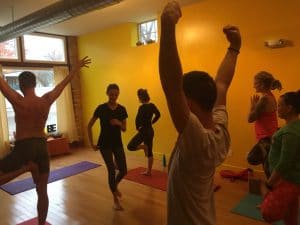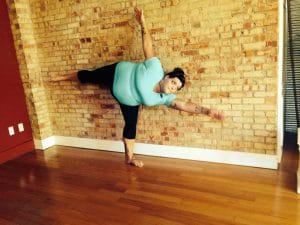I have no balance. This is a common claim of many who want to start yoga. They are hoping for a yoga pose or a video they can watch to “give me balance.”
Balance is not a perfectly level scale.
We are not perfectly symmetrical beings.
We are not perfect.
(just in case you were wondering)
But for some reason many of us have a desire about balance in how we move in our bodies that creates frustration in us.
First, if you walked into the room and are standing up while we’re having this conversation you have balance. This is your subconscious balance where we take for granted that we won’t fall. We probably don’t think about how we lift one leg and how it lands onto the earth each time we take a step. It’s been a long time for many of us since this concept of standing and walking was new or tedious or impossible.
But that’s an inactive state of balancing, letting ourselves be in autopilot.
That will only serve us so far when we want to move in our bodies without falling while standing for an extended period on one leg or when we change our perspective to gravity – kinda upside down, turned sideways, twisted into a knot, just being on our toes.
So, balancing on one limb or on limbs we are not accustomed to standing on requires some focus and some practice… some work.
One of the first concepts to embrace is balance isn’t static. It’s an action and it’s active.
The more we move in our bodies the more we get to observe and practice the constant adjustments and corrections we make to keep our bodies upright.
Stand up. Don’t hold yourself stiff like a military attention. But stand and just feel your muscles in your feet make adjustments as your body makes subtle (or maybe not so subtle) swaying movements against gravity. Notice what muscles in your thighs and even your pelvis and spine alter their engagement and tensions. Can you loosen as many muscles as possible and remain upright? What does it feel like to allow your body to just exist with gravity?
Another key is attention.
How much attention do we pay to what’s going on and what’s required?
If you want to stand on one leg what does that one leg need to do? The leg we’re standing on is the one that matters.
This is where things get a little tricky, funny or frustrating depending on your perspective.
If our attention is on “look, I’m doing it” we may likely lose it. If our attention is on feeling lopsided or wobbly, we may likely lose it. If our attention is on, “I want to stick it and be perfect,” you guessed it, we’re gonna lose it.
Can we bring our attention to feeling stable on the limb that we’re about to ask to support us? What does that limb need? How does the foot feel as it’s holding you? What does your foot do when it’s trying to hold you?
Don’t move beyond what feels stable. Don’t lift a leg higher than the rooted leg can support. This requires patience. Yep, patience.
If it’s new we must embrace the concept of learning and acknowledge how much we practice what we are trying to learn.
We are learning how to exist in our bodies in a different position, in a different shape.
Lastly, do we have the strength to sustain what we are looking to do?
Sometimes, we humanoids believe that since we’re upright we should be able to do all upright things. Then we start to try (without doing all of the three steps above) and we don’t understand why it’s hard and why we’re getting tired. The simplicity of how it looks belies the work involved (remember, we forgot that we are working to stand erect, and half the time we’re kind of lazy about that).
That’s the simple version.
Now, let’s dive a little deeper.
Standing in postures like Tree, our bodies are erect. Our orientation to gravity is about as normal as it comes. Our heads are above our hips. Our feet are on the ground. The only thing to change is weight distribution and the amount of work as we transfer to onestanding leg. We get to practice the action, attention, stability, patience, learning and strength. Practice, not perfection. Just practicing it. Or playing with it.
Now we change the posture and extend the straight leg out in front of us while standing secure on the standing leg (uttitha padangustasana). Here the work of the standing leg is amplified along with the work of holding a straight leg extended out in front of you like you’re kicking in a door, while standing upright without leaning backward (and without falling!). The extended leg is unsupported against gravity. The standing leg and abdominal core of the body have to compensate to hold that protruding limb.
Maybe we learn we can’t extend that leg very high. Where is your starting point then? Can you settle for an inch off the ground still practicing the extension of the leg and focusing on the standing leg? Can we practice the patience to take our time as it takes repetition before lifting it any higher as our strength develops? Can we start to notice where the strength is developing? Is it in the core? The back? The standing leg? The extended leg? All of them?
Now, the final example adds in a change of orientation of our head and the weight distribution on the leg and the core engagement.
Let’s play with Half Moon (Ardha Chandrasana).
This posture is not only one-legged, but the torso is turned sideways, the head is parallel with the floor and not upright and the lifted leg is extended back.
Balance is greatly influenced by our ears and our eyes.
We have now moved the head into a different orientation and plane and we are adding engagement of muscles and put a huge demand on one limb.
If our attention isn’t on the rooted leg we will not hold for even a moment.
Our attention then needs to be distributed to HOW we are moving the other body parts, because it will require constant fluctuating adjustments on the standing leg. Do we need support like a block or a wall as we practice learning and developing strength? How much patience do we get a chance to cultivate?
AND, how much humor do we have?
The end result in a lot of these one-legged, “balancing” postures in yoga isn’t about “strike a pose” a la Madonna. Instead it’s about what we get to learn about ourselves and connect with along the way? We learn about our attention and our patience and our relationship with our strength. Do we have the commitment and fortitude to keep applying ourselves no matter what the final posture looks like? And can we laugh and bring some kindness to the situation? Can we ask for support and help? Do we remain at ease as we learn and practice or do we tense and struggle?
And that’s what yoga is. It’s an awareness into our inner landscape to notice those inner imbalances that are obstacles to peace and ease.
Aho
Ashay
Namaste


